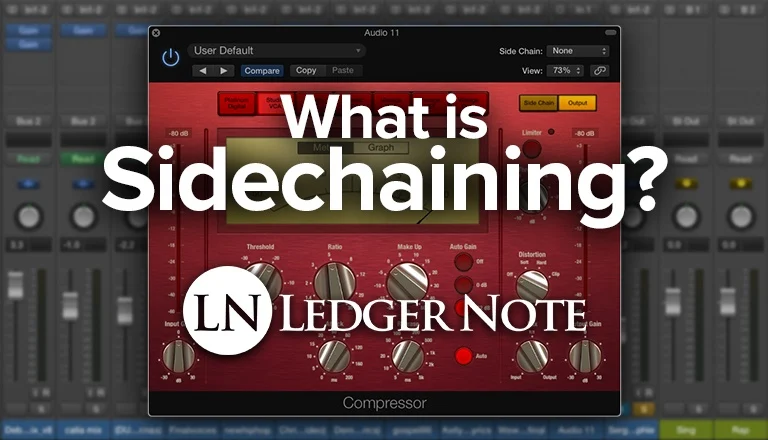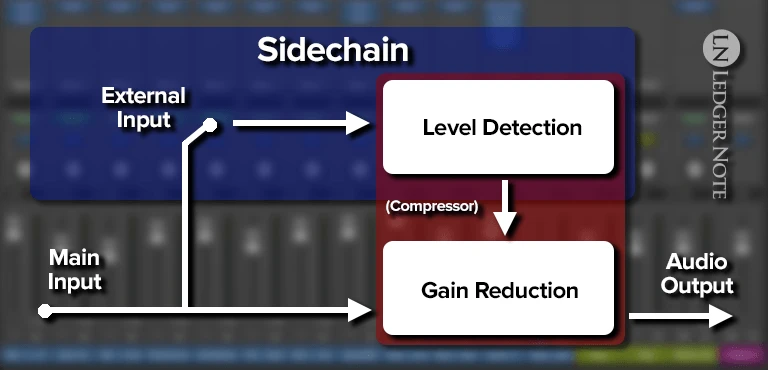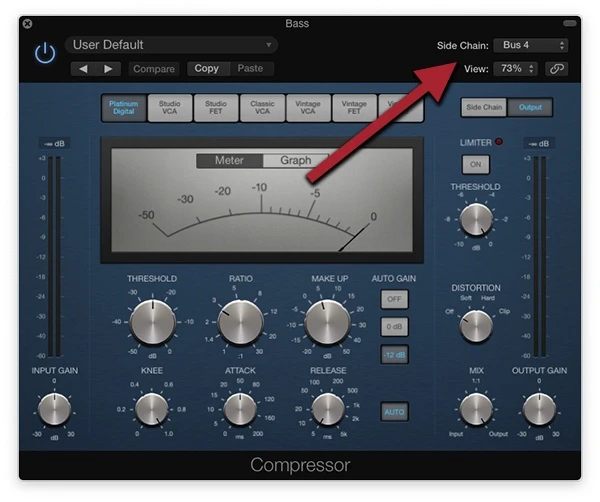
If you’re a music producer of any kind then you’ve tried your hand at mixing. You may even be great at it. You know the ins and outs of equalization, compression, using effects on auxiliary sends, using group buses, etc.
But still, once you sit back to check your mix on a couple of sets of speaker monitors and even your nice headphones, things just aren’t right. The kick and bass are still getting in each other’s way.
No matter how much panning you use, the guitar and keyboard are making the vocals harder to make out clearly.
Luckily for you, there is another trick up your sleeve. You just don’t know about it yet, but we’re here to cure that problem and explain exactly and completely everything you need to know about sidechaining. Using it is pretty simple. It’s just a matter of knowing about it first.
What is Sidechaining?
Sidechaining works exactly like most signal processing effects in that it effects the audio track to which you’ve applied it. The difference is that, instead of that specific track being the trigger for the effect, you’re assigning a different track to be the trigger.
Let’s state that in another way with an example just to make sure we’re being clear. You know how when you use a compressor, the compressor only kicks in when the audio on the track you’ve added it to exceeds the compressor’s threshold level in volume?
Imagine that same scenario, except the compressor kicks in when a different track exceeds its threshold volume.

Sidechaining is the act of letting a different track ride along as a partner to the main track you’re concerned about and letting it give the directions. If you act stupid and your mom smacks you, that’s the normal expectation. But if your brother acts stupid and your mom still smacks you for it, that’s sidechaining!
What Does Sidechaining Do?
The obvious next question is “what does sidechaining do?” The answer is that it entirely depends on how you’re using it. What you have to understand it’s all based on which audio effect you’re using, whether in plugin form or hardware in your rack.
Many effects units can accept a sidechain, and that changes the real answer. But roundabout answer is that it allows you to use a separate track as the trigger for an effect on the main track. Let me give you a real world example based on the most common usage, which is sidechain compression.
We’ve all dealt with a bass drum and a bass line that simply won’t get out of each other’s way. You’ve compressed the kick drum to have more attack. You’ve tried to carve out a dominant frequency range for both. But regardless, it’s still a muddy mess where it’s hard to make out the kick due to the bass playing behind it.
In the case of sidechain compression, we’d assign a compressor to the bass track but select the kick drum bus as the sidechain. This makes it so that the bass will be compressed only when the kick drum occurs. You can see this in the image below.
This is called ducking and is the act of making the bass’ volume reduce itself whenever the kick fires off. When done subtly, the listener won’t notice the bass line’s volume dropping but it will add a ton of clarity to the kick. Let’s look at more examples and it’ll all start to make more sense.
How to Setup a Sidechain
Let me say, though, that setting up a sidechain is often as simple as finding the dropdown box on your plugin’s user interface (most will have this option) and choosing a bus or track as the input (the one giving the directions).

In the image above, we’re looking at the stock compressor plugin from Logic Pro. You can see at the top center that I’ve applied this plugin to the “Bass” track.
At the top right where the arrow is pointing, there is a dropdown menu where I can choose either live inputs from my audio interface or a bus on the mix. I chose the “Kick” bus, though it doesn’t show the name.
This is a free, stock plugin. You can rest assured that any plugin for an effect capable of using a sidechain (usually just gain reduction units) will have the option, especially premium, paid options. This goes for Pro Tools, Ableton, Reaper, FL Studio, etc. A VST that can have it will have it.
It works the exact same way for hardware using a patch cable. The output of the sidechained unit jacks into the sidechain input on the main effects unit. It couldn’t be easier to set up. Understanding it can be a tad confusing so let me give you a few more examples so it can congeal in your mind.
Sidechaining Uses in Mixing
Let me share a handful of more examples of sidechaining in mixing. Most of them include ducking in some fashion, but that’s only one use, albeit the most common. But they all involve getting more clarity out of your mix.
Vocal Clarity – Radio DJ’s use sidechaining to duck the background music any time they start to talk. It’s used on live TV shows when the audience is clapping but the host begins to talk. The idea is to reduce the volume of ambient noises so the main focal point (the vocals) can be heard clearly. This can be done with rhythm guitar or keyboards, too.
Kick & Bass – As mentioned before, you can force the bass to quickly duck out of the way of the kick drum so you don’t have to damage either with too much equalization. It works just like the vocal example above and gives you a lot more headroom. EDM producers will use this method to make the bass “pump” to add a sense of breathing energy to a song.
Make a De-Esser – There’s no reason to do this now but before these existed de-essers were made by sidechaining a compressor to an equalizer to reduce a specific frequency band as laid out on the EQ. You’d target the area of sibilance and plosives with the EQ and only those would be compressed.
Lower the Snare in the Overheads – When miking drums with overheads, you’ll often capture the snare too loudly. You can’t avoid it, but you can do something about it in the mix using sidechaining. Sidechain the snare track to the overheads and you can reduce the volume of the snare in the overheads. This will give you more clarity and a tighter stereo image for the snare.
Add Depth to a Kick – Sometimes you get a kick drum that doesn’t have enough power to it. You can use a sine wave generator to tune a deep frequency to your kick. Then to get the sine wave to only sound off when the kick occurs, you can apply a noise gate to the sine wave and sidechain it to the kick bus. This is a great drum programming trick for you beat producers out there.
Punch Past the Reverb – If you know how to use reverb, then you’re already EQing it but that’s not always enough. Sometimes reverb, pads, and other ambience still get in the way. Rather than manually automate the volume fader, you can use ducking to reduce its volume when it’s being problematic.
If I had to try to simplify the discussion, I’d say that sidechaining has three simple purposes:
- to automate volume automation at a meta-level to gain more clarity
- to add or subtract ambient sounds like reverb, pads, white noise, vinyl record static, etc.
- to create pulsating energy like in electronic dance music songs.
I suspect one day that some clever person is going to invent a brand new usage outside of those three main categories. Perhaps they already have and the world hasn’t caught on yet.
What Does Sidechain Mean? Now You Know!
You lucked out today by asking a great question. Not only do you now know the answer to the question what is sidechaining?, but you know how to use it. Part of the battle is knowing when to use it though, so I made sure to share some applications.
If you only ever used it to bring clarity to the vocals and to help the kick and bass to stop fighting each other, you’d still receive massive benefits to your mixes. Add in the ducking of reverbs and you’ll get another boost to your quality. Apply those some concepts to other instruments and you’ll know all you really need to know about this.
But since mixing is both an art and a science, there’s still plenty of discoveries and unique ways to use this technique that nobody has developed before. So I urge you to experiment and be the first. You never know, it could be the reason you break through and also become a piece of history!